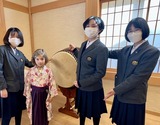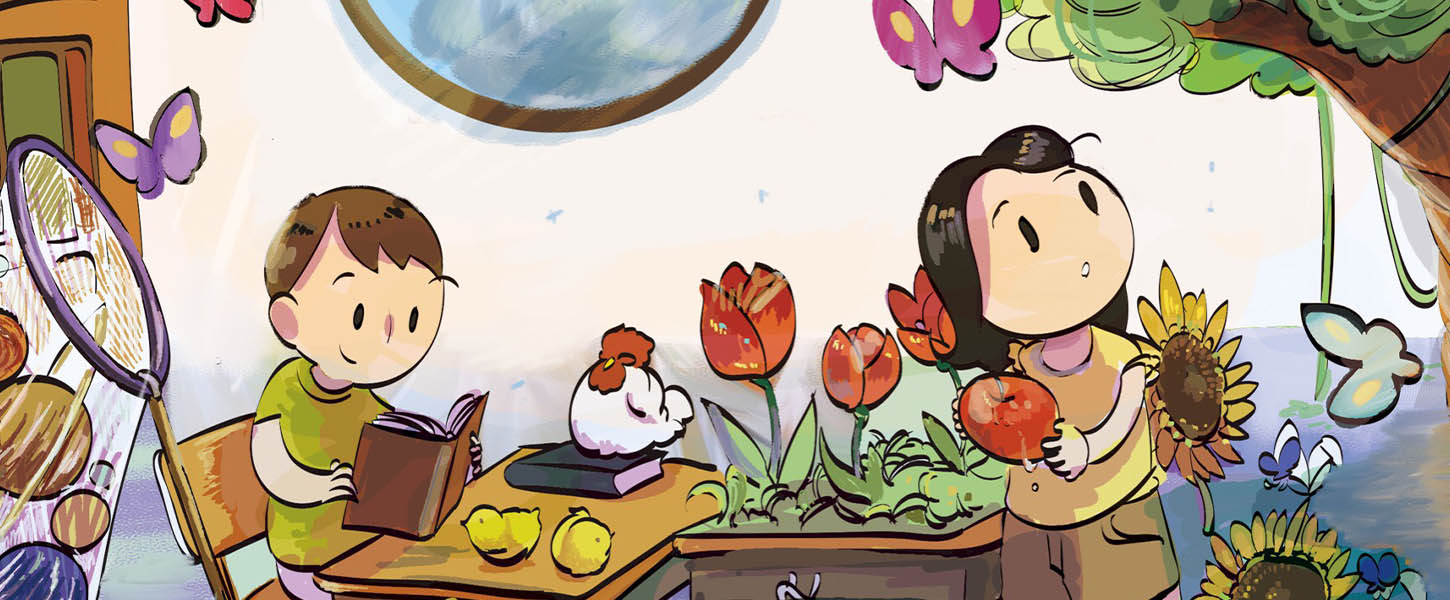
八剱八幡神社 奉納「謡仕舞」(2/4)
本日は、1月28日に行った「八剱八幡神社 秀雲會 奉納 謡仕舞」について、その概要をお伝え致します。
当日は、ご祈祷の神事によって清められたあと、日英仏語の番組の解説、「羽衣」、「橋弁慶」、「猩々」、秀雲先生による「小鍛治」、付祝言の流れで進行しました。
保護者の方々の他にも地域の方や、アメリカ人やフランス人のご家族方もご列席くださり、厳粛な空気のなか執り行うこととなりました。
はじめに番組の解説をご紹介します。
***

◯番組の解説
みなさま、ごきげんよう。これから、第一回 八劔八幡神社奉納 秀雲會 謡仕舞を始めさせていただきます。
Good afternoon everyone. We will begin our performance, after a few explanations on our program.
Bonjour et bienvenue ! Je vais expliquer des programmes pour les enfants. Le Nô est patrimoine culturel immatériel d’UNESCO. C’est un divertissement d’il y a environ 700 ans.
羽衣伝説を元にしたお仕舞「羽衣」は、羽衣を落とした天女さまが、それを拾った青年・白龍の願いに応えて披露する、まるで七宝を振らせるような神々しい舞いが必見です。ぜひ、富士の山を望む「羽衣伝説」の舞台、天女さまが天上界と同じくらいに美しいと賞賛した三保の松原を訪れた気持ちになって、美しい天女の舞をご堪能ください。小鼓とお謡もまた、伸びやかで遥かな音を奏でます。
The first program is “Hagoromo”, based on a legend of a heavenly maiden performing a dance for a fisherman named Hakuryo. Please enjoy the celestial maiden dance as if she makes treasure rain over the land, praising the beauty of the Miho pine grove and the view of Mount Fuji.
Le premier programme est « Hagoromo » qui est basé sur la légende de Hagoromo, et c’est une danse. La légende dit qu’une vierge céleste, qui est similaire des anges, a donné tout le Japon des trésors. C’est à une belle plage de pinède avec le Mt. Fuji en arrière-plan.
源義経と武蔵坊弁慶の劇的な出会いの場面を描く「橋弁慶」は、クライマックスを複数人で謡う連吟でお送りいたします。弁慶・従者のお声を出すことに苦心いたしましたが、男子も交えて一生懸命声を合わせ、重厚さを演出します。鞍馬天狗の弟子といわれた牛若丸の溌剌とした伸びやかなお謡はとても清々しく、見どころです。源氏の宿願であった平家滅亡を成し遂げることになる2人の劇的な出会いの場面を、本日はおよそ850年前の五条大橋へ時間旅行をして、ご一緒に、目撃いたしましょう。
The second program, “Hashi Benkei,” will take you back to around 850 years ago in Kyoto. Characters from the famous story, Benkei, and Ushiwaka-maru, meet on the Gojo Bridge. The highlight of this program is the contrast between the deep and strong voice of Benkei and the chorus and Ushiwaka-maru’s bright, melodious voice.
La deuxième programme, «Hashi Benkei», est sur l’enfance d’un samuraï très célèbre. C’est le chœur, et sur le pont de Gojo à Kyoto, il y a 850 ans.
親孝行の青年・高風と海に住む精霊・猩々の交流をめでたく舞い謡う「猩々」は、二人が可愛らしく心を合わせ、同時に舞う「相舞(あいまい)」でお送りします。小鼓やお謡も心を一つに、丁寧に行います。かわいい猩々がお酒を酌み交わそうとやってくる場面を思い浮かべながら、お楽しみ下さい。
The third program is “Shojo,” a piece derived from China. It is a joyful dance and chant about Shojo, a spirit who loves sake, and a young man named Kofu. Please enjoy two dancers synchronizing in a rare “Aimai” style and the hand drums and chanting performed in unison.
Le troisième programme, «Shōjō», est une histoire chinoise. C’est sur un jeune homme filial qui s’est entendu
avec un esprit qui habite dans la mer, qui s’appelait Shōjō. Shōjō a donné un pot de liqueur sans fin à l’homme, mais il s’est avéré que c’était son rêve. Cependant, le pot était toujours là, est la famille est devenue riche. Ce programme est habituellement pour qu’une personne danse, mais aujourd’hui, deux personnes vont danser, et c’est rare!
最後に、番外仕舞では、ここ八剱様にちなみ、実在の刀工・小鍛冶宗近が稲荷明神のご神体と相槌を打って名刀を完成させる「小鍛冶」という演目を、能楽師の秀雲先生による本格的なお仕舞で披露いたします。見るものを飽きさせない、秀雲先生のきびきびした動きと迫力は必見です。お謡は、爽快さを表現できるように頑張ります。ぜひご注目くださいね。
Lastly, “Kokaji” is about a swordsmith, Munechika, forging a katana with the deity Inari Myojin. The powerful
and dynamic dance performance by Shu-un sensei, our teacher and professional Noh performer, will keep you on the edge of your seat.
Le programme final, «Kokaji», est dansé par notre enseignant. C’est sur un épéiste qui fabrique de bonnes épées.
どの演目もそれぞれの役割の中で自由に演目を解釈し、心を一つにして披露いたします。最後まで皆さまと共にこの会を作り上げ、神様に奉納させていただけますと幸いです。
それでは、よろしくお願いいたします!
Please enjoy the joy and delight of our performance!
Imaginons ce qui se passe !
***
次回は秀雲會の解説を取り仕切ってくれたOG(ヨハネ生)の声をお届けします。







